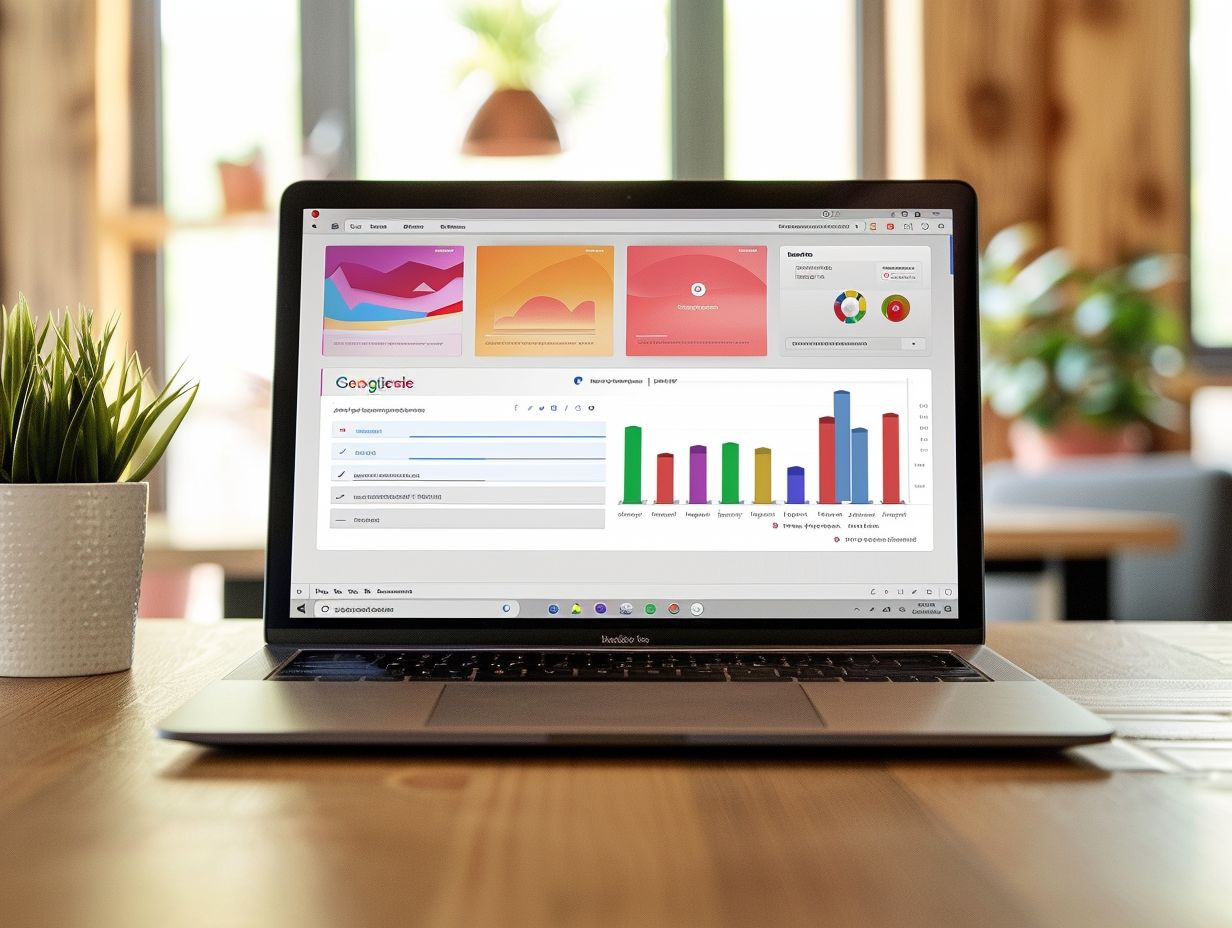Securing Your Google Slides Presentations: Tips and Tricks
In the digital age, securing Google Slides presentations is crucial to prevent theft, unauthorized access, and manipulation of sensitive information. Unsecured presentations may result in data breaches, unauthorized access to sensitive data, and damage to the reputation of the presentation creators.
Best practices for securing Google Slides presentations include using strong passwords, encryption, and restricting access to sensitive information. This also involves implementing secure sharing conditions, such as turning off external sharing for Google Slides.
Additional tips for ensuring presentation security include regularly backing up files, using two-factor authentication, and keeping software up to date. These recommendations aim to enhance the security of Google Slides presentations.
Key Takeaways:
Why is Securing Your Google Slides Presentations Important?
Ensuring security in Google Slides presentations is crucial to prevent unauthorized access and safeguard the integrity and confidentiality of professional content. When only authorized individuals can access a presentation, the design, themes, and critical information within the presentation remain protected. Unauthorized access may lead to the exposure of sensitive information, potentially harming the credibility of the content owner and their associates.
Data breaches can result in financial and legal consequences that disrupt business operations. Implementing effective security measures for content promotes professionalism and reliability, fostering trust between clients and partners. A strengthened brand reputation positions the trusted source as a go-to for valuable information and referrals.
Potential Risks of Unsecured Presentations
Failure to protect your Google Slides can expose your valuable content to risks such as unauthorized access, data theft, or misuse of information by unintended audiences. It is crucial to protect Google Slides to maintain control over your content and ensure it reaches the intended audience.
Unprotected Google Slides presentations can result in sensitive data being accessed and used in ways that may lead to breaches of data privacy and confidentiality. Unauthorized sharing of information can cause reputational or legal harm. Unsecured Google Slides materials can result in information misuse, distortion of the intended message, and confusion among viewers, ultimately impacting audience trust and engagement. This can diminish the effectiveness of the presentation and hinder the achievement of desired outcomes.
Best Practices for Securing Your Google Slides Presentations
Securing Google Slides presentations is crucial for safeguarding intellectual property, design, themes, and content. Utilizing the available security features in Google Drive and Google Slides helps prevent unauthorized access and dissemination of valuable information and resources. Encrypting files before uploading them to the cloud is a key step in this process.
Encryption transforms files into a secure code that is incomprehensible to unauthorized users without the decryption key, thus safeguarding content from unauthorized viewing or distribution. Creating strong, unique passwords for your Google account and individual presentations adds an extra layer of security. Setting permissions and sharing settings to restrict access to sensitive content is equally important in preventing unauthorized individuals from viewing, editing, or sharing presentations.
Creating Strong Passwords
It is essential to create strong and unique passwords for your Google Slides presentations to enhance their security and prevent unauthorized access. Strong passwords provide an additional layer of protection to your content.
The key aspect of securing passwords is ensuring their strength. Regularly changing passwords can also bolster security measures. For Google Slides, strong passwords should consist of 12-16 characters and include a combination of upper-case letters, lower-case letters, numbers, and special characters. Avoid using easily guessed personal information such as birthdays and refrain from common words.
Utilizing a password manager can assist in securely storing and generating complex passwords for your presentations.
Utilizing Encryption
Encryption in Google Slides enhances security by encoding information in presentations, thereby preventing unauthorized access and safeguarding data confidentiality. When applied to sensitive data, encryption ensures that information can only be deciphered with a specific decryption key, making it extremely difficult for unauthorized individuals to intercept or view.
Apart from enhancing confidentiality, encryption also promotes data integrity and authentication, aiding in the prevention of cyberattacks, unauthorized access, and data breaches in Google Slides presentations and associated documents. This contributes to a higher level of safety and security in the digital era.
Limiting Access to Sensitive Information
Limiting access to sensitive data in Google Slides involves restricting views and editing rights within a presentation to minimize the risk of data leakage. By managing permissions and other sharing settings, you can control who can view and edit the information.
One method to restrict access to sensitive data in Google Slides is by assigning permissions to each individual, specifying roles such as editor, viewer, or commenter to control their actions within the presentation.
Another approach is to apply sharing restrictions that determine whether the presentation is accessible to anyone with the link, specific individuals, or only those within the organization.
Enhanced privacy measures like password protection or domain-level restrictions can be implemented to further enhance the security of the information.
Additional Tips for Protecting Your Google Slides Presentations
Along with encryption and strong passwords, regular backups, two-factor authentication, and keeping software updated are also important tips for protecting your presentations. By backing up your presentations, you ensure that if your data is ever compromised, you will be able to easily restore your work.
Two-factor authentication requires an additional verification step beyond just your password. Regularly updating software patches any vulnerabilities that hackers can exploit, adding an additional level of protection. When combined, these practices create a strong system to protect your sensitive data on Google Slides.
Regularly Backing Up Your Presentations
It is important to regularly back up Google Slides presentations to prevent data loss and ensure that content can be accessed and edited in case of an emergency. Backing up on platforms like Google Drive helps safeguard important content from potential risks.
Implementing a backup strategy that includes weekly or bi-weekly backups of presentations helps mitigate the risk of data disasters. Along with cloud services like Google Drive, utilizing external hard drives or network-attached storage adds extra redundancy.
Establishing a structured naming convention for backup files and regularly testing data recovery procedures enhances the effectiveness of backups and recovery processes.
Using Two-Factor Authentication
To access a Google Slides account with two-factor authentication, a second form of identification is required. This extra security measure is crucial for safeguarding presentation documents and ensuring that private content remains protected.
Two-factor authentication adds an additional barrier that prevents unauthorized access to one’s data. Setting up two-factor authentication is simple and offers a range of user-friendly and customizable verification methods, including text message codes, authenticator apps, or security keys. By combining something you know (password) with something you have (mobile device), two-factor authentication significantly reduces the risk of unauthorized access, allowing only authorized users to view or edit important presentations.
Keeping Your Software and Operating System Up to Date
To ensure the security of your Google Slides presentations, it is important to update your software and operating system regularly. These updates help patch vulnerabilities in the existing version, thereby preventing hackers from accessing your content. Along with enhancing security, regular software updates also improve the performance and functionality of computers and mobile devices.
According to cybersecurity experts at the Australian Cyber Security Centre (ACSC), operating system updates often include critical security upgrades that address known vulnerabilities in software applications and operating systems. Therefore, users should always ensure that their devices are running the latest operating system version. In the modern landscape of cyberattacks, it is clear that systems not kept up to date are at high risk of being hacked.
To mitigate this risk, updates should be proactive and automatic. Failure to update systems can leave presentations vulnerable to unauthorized access, potentially resulting in data theft or loss. Keeping all applications and operating systems updated significantly reduces the likelihood of unauthorized access.
Final Thoughts and Recommendations
Ensuring the security of your Google Slides presentations is essential for safeguarding your professional content and maintaining the integrity of your data. By adhering to best practices, utilizing encryption, and limiting the exposure of sensitive information, you can safeguard your critical presentations and uphold the confidence of your audience.
Enhancing security measures with strong passwords and two-factor authentication adds an extra layer of protection. Keeping software up to date and utilizing secure networks further reduce the risk of data breaches. Conducting regular security audits and staying informed about the latest security risks are crucial for recognizing and addressing potential vulnerabilities.
As data security is an ongoing effort, remaining vigilant and proactive are key to safeguarding your Google Slides presentations.
Frequently Asked Questions
What are some tips for securing my Google Slides presentations?
Some tips for securing your Google Slides presentations include setting a strong password, limiting access to specific users, and using the “restricted” mode to prevent downloading, printing, or copying of your presentation.
How can I set a password for my Google Slides presentation?
To set a password for your Google Slides presentation, click on “File” and then select “Protect presentation.” From there, you can choose to set a password for viewing, editing, or both.
Can I limit access to my Google Slides presentation to specific users?
Yes, you can limit access to your Google Slides presentation to specific users. When sharing your presentation, click on “Advanced” and then select “Specific people” under “Who has access.” From there, you can enter the email addresses of the users you want to give access to.
What is the “restricted” mode in Google Slides?
The “restricted” mode in Google Slides allows you to limit the actions that viewers can take on your presentation. This includes preventing downloading, printing, or copying of your presentation.
Can I revoke access to my Google Slides presentation after it has been shared?
Yes, you can revoke access to your Google Slides presentation at any time. Simply click on the “Share” button and select “Advanced.” From there, you can remove specific users or change the sharing settings for your presentation.
Is it possible to add watermarks to my Google Slides presentation for added security?
Yes, you can add watermarks to your Google Slides presentation by inserting an image or text box and adjusting the transparency. This can help prevent unauthorized sharing or copying of your presentation.










